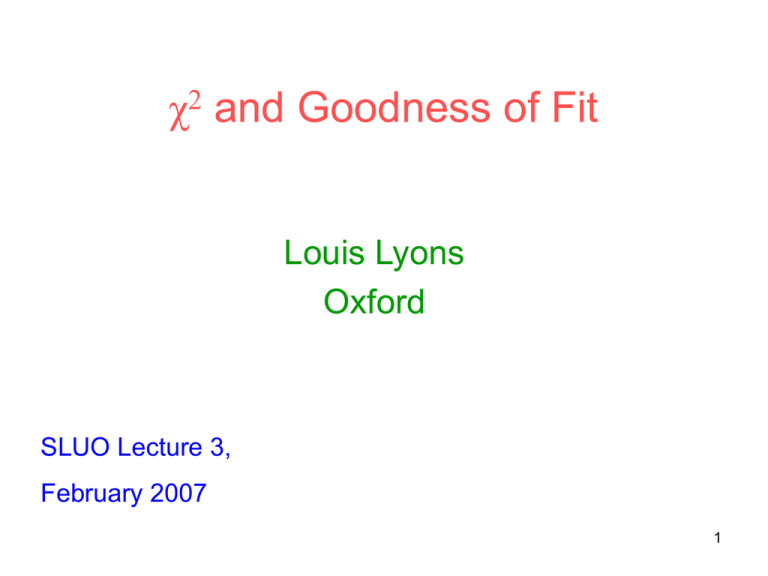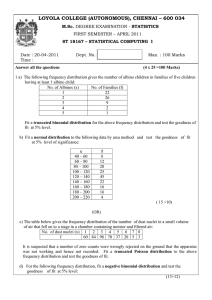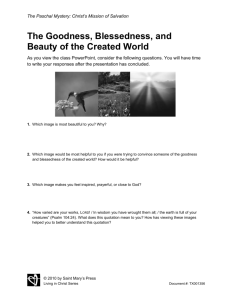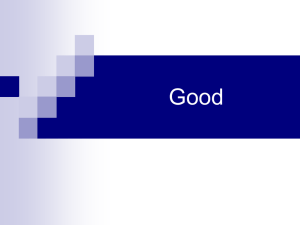χ and Goodness of Fit Louis Lyons Oxford
advertisement

χ2 and Goodness of Fit
Louis Lyons
Oxford
SLUO Lecture 3,
February 2007
1
Least squares best fit
Resume of straight line
Correlated errors
Errors in x and in y
Goodness of fit with χ2
Errors of first and second kind
Kinematic fitting
Toy example
THE paradox
2
3
4
5
6
Straight Line Fit
N.B. L.S.B.F. passes through (<x>, <y>)
7
Error on intercept and gradient
That is why track parameters specified at track ‘centre’
8
See Lecture 1
b
y
a
x
9
If no errors specified on yi (!)
10
Summary of straight line fitting
• Plot data
Bad points
Estimate a and b (and errors)
• a and b from formula
• Errors on a’ and b
• Cf calculated values with estimated
• Determine Smin (using a and b)
• ν=n–p
• Look up in χ2 tables
• If probability too small,
IGNORE RESULTS
• If probability a “bit” small, scale errors?
Asymptotically
12
Measurements with correlated errors
e.g. systematics?
13
STRAIGHT LINE: Errors on x and on y
14
Comments on Least Squares method
1) Need to bin
Beware of too few events/bin
2) Extends to n dimensions
but needs lots of events for n larger than 2 or 3
3) No problem with correlated errors
4) Can calculate Smin “on line” i.e. single pass through data
Σ (yi – a –bxi)2 /σ2 = [yi2] – b [xiyi] –a [yi]
5) For theory linear in params, analytic solution
y
6) Hypothesis testing
x
Individual events
(e.g. in cos θ )
yi±σi v xi
(e.g. stars)
1) Need to bin?
Yes
No need
4) χ2 on line
First histogram
Yes
16
17
Moments
Max Like
Least squares
Easy?
Yes, if…
Normalisation,
maximisation messy
Minimisation
Efficient?
Not very
Usually best
Sometimes = Max Like
Input
Separate events
Separate events
Histogram
Goodness of fit
Messy
No (unbinned)
Easy
Constraints
No
Yes
Yes
N dimensions
Easy if ….
Norm, max messier
Easy
Weighted events
Easy
Errors difficult
Easy
Bgd subtraction
Easy
Troublesome
Easy
Error estimate
Observed spread,
or analytic
Main feature
Easy
- ∂2 l
∂pi∂pj
Best
-1/2
∂2S
2∂pi∂pj
-1/2
Goodness of Fit
19
‘Goodness of Fit’ by parameter testing?
1+(b/a) cos2θ
Is b/a = 0 ?
‘Distribution testing’ is better
20
Goodness of Fit: χ2 test
1) Construct S and minimise wrt free parameters
2) Determine ν = no. of degrees of freedom
ν=n–p
n = no. of data points
p = no. of FREE parameters
3) Look up probability that, for ν degrees of freedom,
χ2 ≥ Smin
Works ASYMPTOTICALLY, otherwise use MC
[Assumes yi are GAUSSIAN distributed with mean yith
and variance σi2]
22
23
24
χ2 with ν degrees of freedom?
ν = data – free parameters ?
Why asymptotic (apart from Poisson Gaussian) ?
a) Fit flatish histogram with
y = N {1 + 10-6 cos(x-x0)} x0 = free param
b) Neutrino oscillations: almost degenerate parameters
y ~ 1 – A sin2(1.27 Δm2 L/E)
2 parameters
1 – A (1.27 Δm2 L/E)2
1 parameter
Small Δm2
25
26
Goodness of Fit:
Kolmogorov-Smirnov
Compares data and model cumulative plots
Uses largest discrepancy between dists.
Model can be analytic or MC sample
Uses individual data points
Not so sensitive to deviations in tails
(so variants of K-S exist)
Not readily extendible to more dimensions
Distribution-free conversion to p; depends on n
(but not when free parameters involved – needs MC)
27
Goodness of fit: ‘Energy’ test
Assign +ve charge to data
; -ve charge to M.C.
Calculate ‘electrostatic energy E’ of charges
If distributions agree, E ~ 0
If distributions don’t overlap, E is positive
v2
Assess significance of magnitude of E by MC
N.B.
v1
1) Works in many dimensions
2) Needs metric for each variable (make variances similar?)
3) E ~ Σ qiqj f(Δr = |ri – rj|) ,
f = 1/(Δr + ε) or –ln(Δr + ε)
Performance insensitive to choice of small ε
See Aslan and Zech’s paper at:
http://www.ippp.dur.ac.uk/Workshops/02/statistics/program.shtml
28
Wrong Decisions
Error of First Kind
Reject H0 when true
Should happen x% of tests
Errors of Second Kind
Accept H0 when something else is true
Frequency depends on ………
i) How similar other hypotheses are
e.g. H0 = μ
Alternatives are: e
π K p
ii) Relative frequencies: 10-4 10-4 1 0.1 0.1
Aim for maximum efficiency
Low error of 1st kind
maximum purity
Low error of 2nd kind
As χ2 cut tightens, efficiency and purity
Choose compromise
30
How serious are errors of 1st and 2nd kind?
1)
Result of experiment
e.g Is spin of resonance = 2?
Get answer WRONG
Where to set cut?
Small cut
Reject when correct
Large cut
Never reject anything
Depends on nature of H0 e.g.
Does answer agree with previous expt?
Is expt consistent with special relativity?
2) Class selector e.g. b-quark / galaxy type / γ-induced cosmic shower
Error of 1st kind:
Loss of efficiency
Error of 2nd kind:
More background
Usually easier to allow for 1st than for 2nd
3) Track finding
32
Goodness of Fit: = Pattern Recognition
= Find hits that belong to track
Parameter Determination = Estimate track parameters
(and error matrix)
33
34
Kinematic Fitting: Why do it?
35
Kinematic Fitting: Why do it?
36
37
Toy example of Kinematic Fit
38
39
PARADOX
Histogram with 100 bins
Fit with 1 parameter
Smin: χ2 with NDF = 99 (Expected χ2 = 99 ± 14)
For our data, Smin(p0) = 90
Is p1 acceptable if S(p1) = 115?
1) YES.
Very acceptable χ2 probability
2)
σp from S(p0 +σp) = Smin +1 = 91
But S(p1) – S(p0) = 25
So p1 is 5σ away from best value
NO.
40
41
Next time : Discovery and
p-values
Hope: LHC moves us
from era of ‘Upper
Limits’ to that of
DISCOVERY
43





